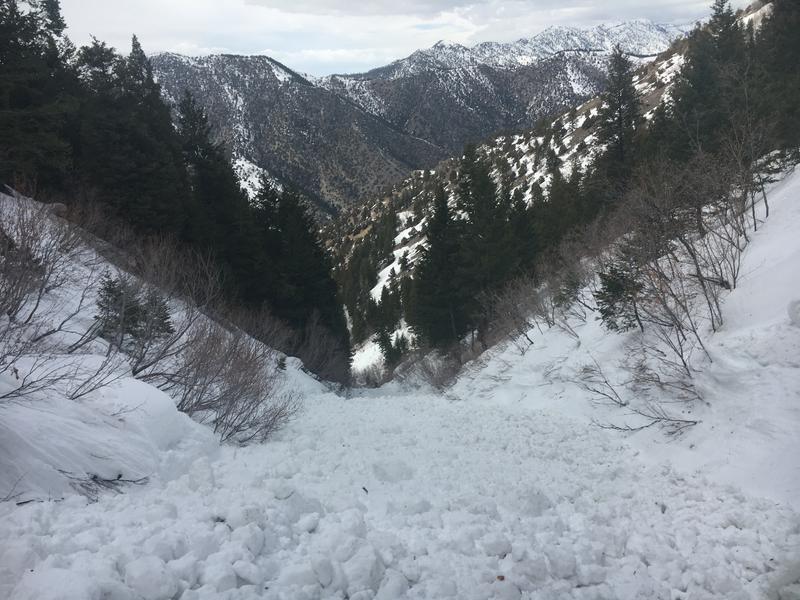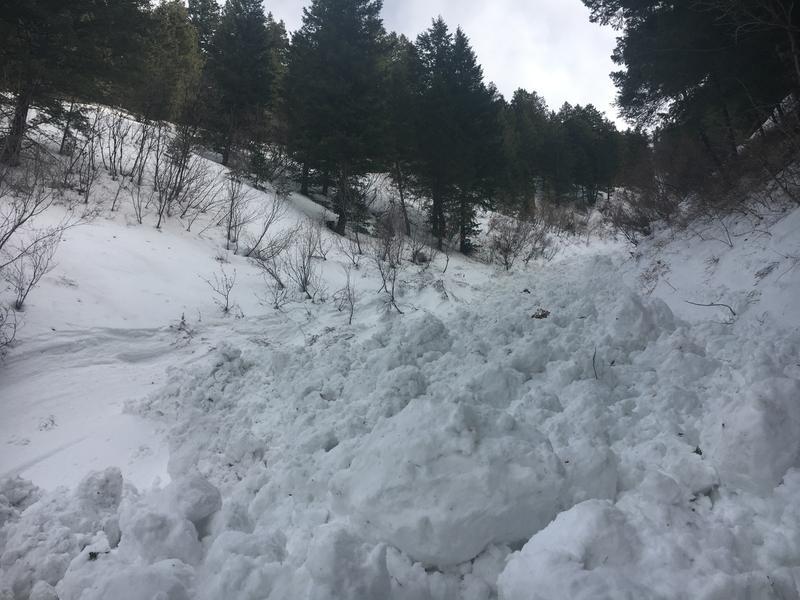Observer Name
R Choi, S Kinosian
Observation Date
Saturday, March 7, 2020
Avalanche Date
Saturday, March 7, 2020
Region
Logan » Logan Canyon » Coyote Canyon » North Syncline Gully
Location Name or Route
N Syncline Gully
Elevation
7,900'
Aspect
North
Slope Angle
Unknown
Trigger
Unknown
Trigger: additional info
Unintentionally Triggered
Avalanche Type
Wet Loose
Avalanche Problem
Wet Snow
Depth
4'
Width
25'
Vertical
1,500'
Caught
1
Carried
1
Accident and Rescue Summary
A very close call here. The skier(s) is very lucky to have survived this long ride in very heavy, cement-like, wet avalanche debris with only bumps and bruises and a lost ski pole....
Comments
Warming temperatures and two nights of slightly above freezing temperatures on Logan Peak were the primary cause for concern for the day. The UAC Logan report stated: "Warm temperatures in the mountains today, strong March sun, and potential green-housing will create heightened wet avalanche conditions and MODERATE danger, especially in sheltered terrain. People could trigger wet avalanches on very steep slopes, most likely in rocky areas with shallow, melt softened snow. Natural wet loose avalanches and cornice falls will become possible in some areas during the heat of the day."
Although there were broken clouds most of the day, a consistent W breeze kept temperatures cold on exposed terrain above 7000'. After skiing another adjacent N facing line in the vicinity, we decided to ski a sheltered N facing line into the NW drainage off the N Syncline Trail specifically to avoid direct solar warming. We observed no visible natural activity all day on similar steep terrain; however, we did experience warm snow glopping on skins in areas that had canopy greenhousing.
At 2:30PM, the snow at the entrance to the line at 8330' was firm, supportable, and still frozen. After passing through a narrow choke in the cliffs one at a time, we entered the start of the continuous chute individually. We discovered that the line had already partially slid and found ourselves skiing on the firm bed surface and minor wet debris. Skier 1 skied to 7300' and pulled off to skier's left at the vegetation line and hailed Skier 2 on the radio to begin skiing down. Skier 2 skied to 7400' where they were knocked over from behind by a large moving wet slide and carried to 6600'. Skier 2 was able to stay on top of the dense moving snow for the entirety of the 800' slide. Skier 2 fortunately sustained only minor bumps and bruises, and lost one ski pole. Immediately after the slide, both skiers were able to communicate via radio and ski out the rest of the line together.
We estimate that the slide ran for a total of 1500' and filled in the width of the chute with debris for the extent of the run. It is unclear where the start zone was located or whether or not this was a skier-triggered slide. The amount of snow in motion when skier 2 got carried was considerably greater than could have been started by ski sloughing. There were no cornices present at the top of the line. The average slope angle of the chute was in the mid-30s. While we did not observe any local natural activity, there were other wet slides reported at similar times, aspects, and elevations in LCC and Provo.
In hindsight, we started skiing this line too late in the day, after first deciding to ski another line. Clouds, wind, and N aspects were insufficient to halt the warming trend at mid-elevations. Even though the start of the line was cold and windy, conditions were considerably warmer 1000' down - something we only realized once had begun skiing the line.


Coordinates



